Therapeutic Art Projects: A Creative Path to Mental Wellness and Self-Discovery
February 1, 2025
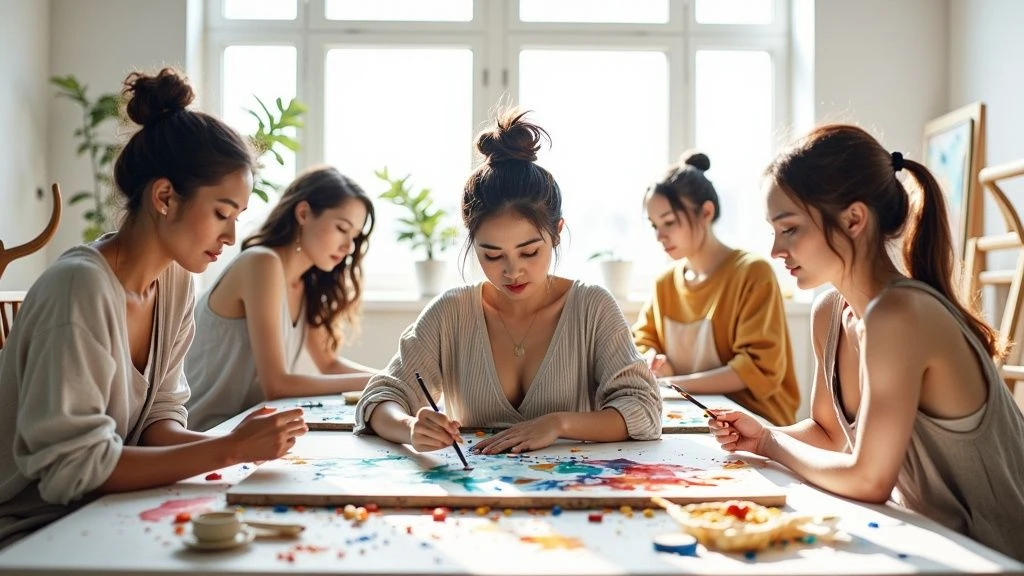
Understanding the Power of Therapeutic Art
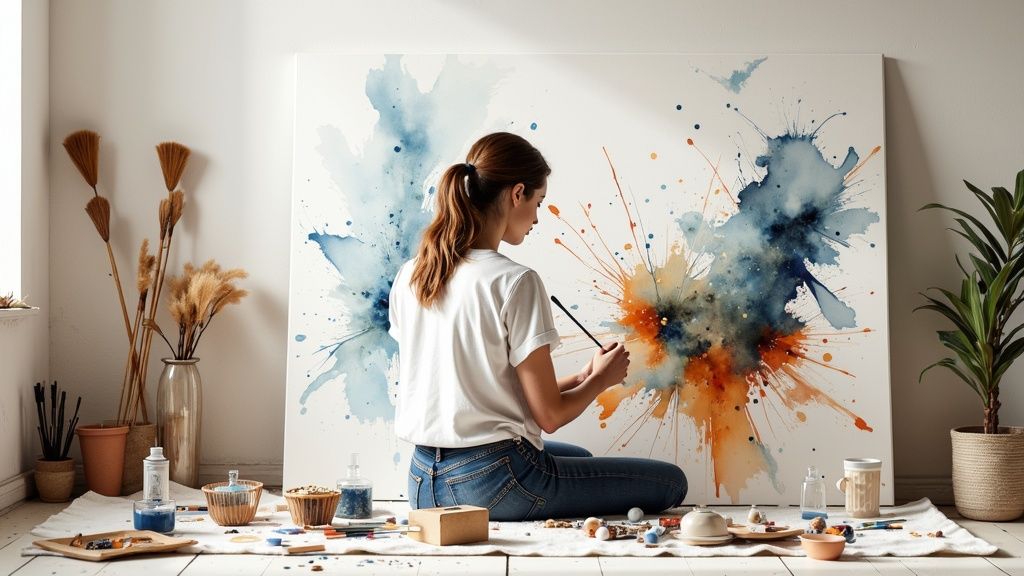
When words fail, art speaks. Therapeutic art creates a bridge between our inner emotions and outer expression, offering a powerful path to mental wellbeing that goes beyond traditional talk therapy. By tapping into our natural ability to create and express ourselves visually, art helps us process complex feelings and experiences that we might struggle to put into words.
How Therapeutic Art Works
The beauty of therapeutic art lies in its simplicity - you don't need to be Picasso to benefit from it. The magic happens in the process of creation itself, whether you're swirling paint across canvas, molding clay with your hands, or simply doodling in a notebook. These activities create a judgment-free zone where you can explore your thoughts and feelings at your own pace.
Think of it like emotional detective work through art. Someone dealing with anger might discover relief in bold brush strokes or find peace in methodically shaping clay. The finished artwork becomes a kind of emotional snapshot - a starting point for deeper conversations with a therapist or personal reflection.
The History and Growth of Therapeutic Art
Art therapy has deep roots in mental health care, beginning in the early 1900s with pioneers like Margaret Naumburg who saw art's potential for emotional healing. The field grew when British artist Adrian Hill used art to help tuberculosis patients in the 1940s. A major milestone came in 1969 with the creation of the American Art Therapy Association, which helped establish art therapy as a respected profession. Want to learn more? Check out these fascinating art therapy statistics.
The Benefits of Therapeutic Art Projects
Art therapy opens doors to healing in many ways:
- Emotional Regulation: Art helps you recognize and manage your feelings more effectively
- Stress Reduction: Creating art naturally calms your mind and body
- Improved Self-Esteem: Making something with your own hands builds confidence
- Enhanced Communication: Art gives voice to feelings when words feel inadequate
- Trauma Processing: Visual expression provides a gentle way to work through difficult experiences
The best part? You don't need any artistic talent to benefit from therapeutic art. Whether you're dealing with everyday stress or processing deeper emotional challenges, picking up a paintbrush or pencil might be the first step on your journey to healing.
The Science Behind Therapeutic Art Projects
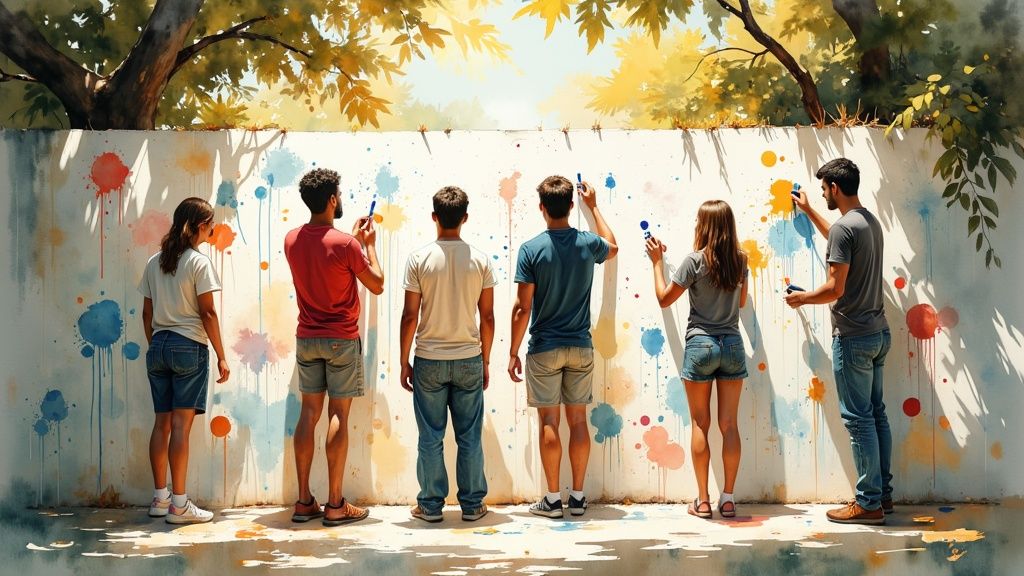
Making art is more than a creative hobby - it's a scientifically proven way to support mental health and emotional wellbeing. When we engage in artistic activities, measurable changes occur in our brains that help us process emotions and reduce stress. Understanding this science helps explain why art therapy can be such an effective tool for improving mental health.
How Creative Expression Rewires the Brain
When you pick up a paintbrush or pencil, multiple areas of your brain spring into action. The visual cortex processes colors and shapes while the motor cortex guides your hand movements. This creates a powerful mind-body connection that helps you feel more centered and in control. For people dealing with anxiety or emotional challenges, this focused engagement can provide welcome relief from racing thoughts and worries.
Making art also triggers the release of dopamine, the brain's natural feel-good chemical. Just like the satisfaction of completing a workout, finishing an art project gives you a natural mood boost. This explains why even simple creative activities like coloring can lift your spirits and reduce stress. The good feelings encourage you to keep creating, building an upward spiral of emotional benefits.
The Impact of Art on Stress and Mental Health
Research clearly shows that making art can improve mental health in measurable ways. In one key study, 200 participants spent just 45 minutes on creative activities and showed significant drops in stress hormones - regardless of their artistic experience or skill level. The results demonstrate that anyone can benefit from art therapy, not just "artistic" people. For more research findings, check out these art therapy statistics and insights.
Applying Neuroscience to Therapeutic Art Practice
By matching specific art activities to therapeutic goals, we can help people get the most benefit from creative expression. Someone who struggles to express emotions might find freedom in abstract painting, while a person seeking calm might prefer the structured patterns in adult coloring books. Learn more about therapeutic coloring in our complete guide to adult coloring books. The key is finding art forms that resonate with each person's needs and interests. This personalized approach helps ensure that art therapy provides meaningful emotional support and stress relief.
Creating Your Therapeutic Art Space
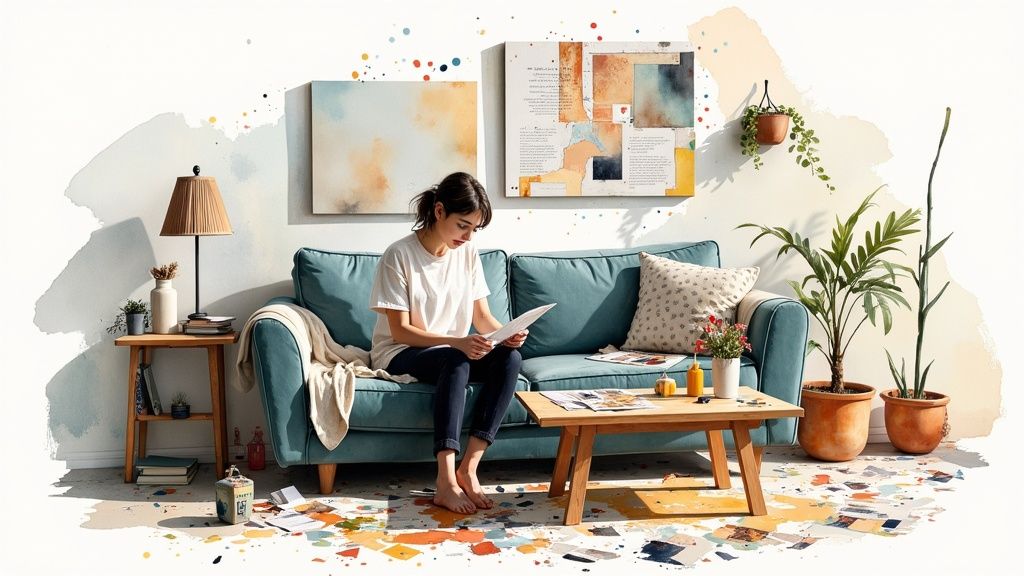
Setting up a dedicated space for art therapy doesn't require anything fancy - just a thoughtfully arranged area that helps you feel safe and supported while creating. Whether you carve out a quiet corner of your bedroom or have a whole room to work with, the key is creating an environment that puts you at ease and encourages free expression. Think about both the practical elements, like having good lighting and storage solutions, as well as the overall feeling you want the space to have.
Essential Elements of a Therapeutic Art Space
Good lighting makes a huge difference in how a creative space feels and functions. Natural light is ideal since it lifts mood and energy levels. If that's not possible in your space, consider using full-spectrum bulbs that mimic sunlight. This simple change can make your art area much more inviting.
Keeping art supplies tidy and accessible helps maintain creative flow. A jumbled mess of materials can feel overwhelming and drain your energy before you even begin. Simple solutions like clear bins, labeled containers, and open shelving make it easy to find what you need when inspiration strikes.
The atmosphere should help you relax and stay focused. Try adding some calming touches like a few plants, quiet background music, or essential oils. These small details can transform a plain room into a peaceful retreat where you feel free to explore and express yourself through art without judgment.
Setting Up Your Space for Different Needs
Your art therapy space should flex to accommodate both solo work and group activities. For individual sessions, you just need the basics - a comfortable chair, stable work surface, and your supplies within reach. This minimal setup supports quiet reflection and personal exploration.
When working with others, arrange the space to encourage connection. Position chairs and tables in a circle to make conversation natural. Leave enough open space for people to move around comfortably. The layout should help everyone feel included while still having their own workspace.
Budget-Friendly Solutions for Your Art Space
Creating an art therapy space doesn't have to be expensive. Get creative with storage - clean glass jars work perfectly for brushes and markers. Old boxes and bins can organize supplies just as well as fancy containers. The key is finding practical solutions that work for you.
Look for art supplies at discount stores or buy basics in bulk when they go on sale. Thrift stores often have unexpected treasures like frames, containers, and even art materials. You can also incorporate found objects and recycled items into your creative process. Focus your budget on the essential tools you'll use most often, and build your collection gradually. What matters most is that your space feels welcoming and supports your creative healing journey.
Art Projects That Create Real Growth and Healing
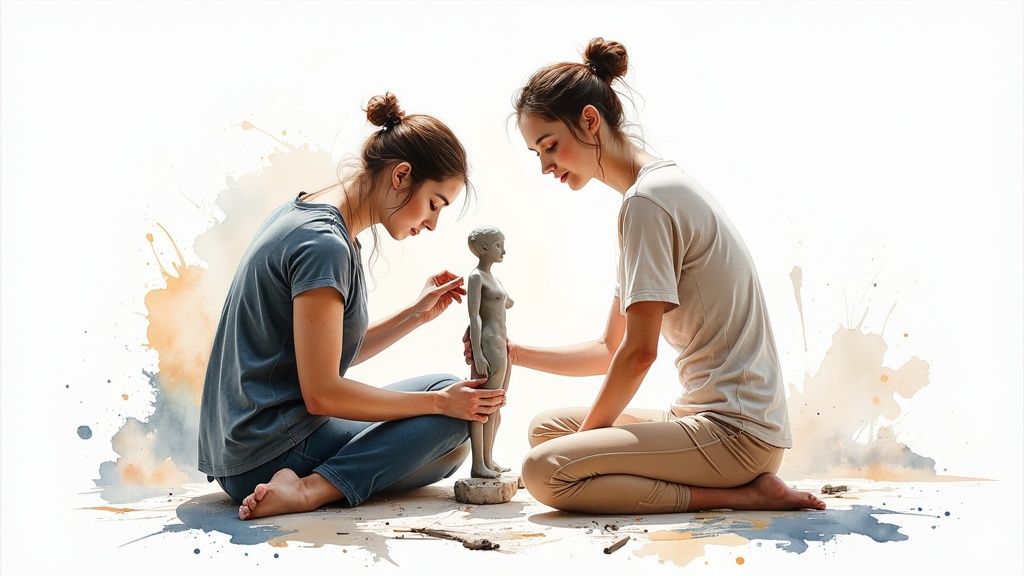
Art therapy gives people powerful tools for expressing emotions and finding inner healing. Let's explore ten carefully selected projects that help unlock emotional growth through creative expression. Each project comes with clear goals and steps, plus expert tips for adapting the techniques to meet different emotional needs.
Creative Projects That Spark Transformation
Here are ten art therapy projects, along with their core purposes and ways to adapt them:
| Project | Objective | Adaptations |
|---|---|---|
| 1. Color Exploration: | Express emotions through color choices | Create emotion-based color palettes (bright for joy, muted for calm) |
| 2. Texture Collage: | Process complex feelings with tactile materials | Mix materials from silk to sandpaper for sensory discovery |
| 3. Self-Portrait Sculpture: | Build self-awareness and acceptance | Use clay, wire, or found objects to show different parts of yourself |
| 4. Mandala Creation: | Find focus and inner calm | Follow set patterns or create free-flowing designs |
| 5. Dream Visualization: | Explore unconscious thoughts and feelings | Use prompts to remember and express dream images |
| 6. Emotional Landscape: | Paint feelings as visual scenes | Create abstract shapes and colors showing inner worlds |
| 7. Mask Making: | Explore different sides of personality | Decorate blank masks to show hidden emotions |
| 8. Scribble Drawing: | Release built-up energy | Try different tools and paper sizes for free expression |
| 9. Clay Work: | Ground emotions through touch | Focus on hand-building and feeling the clay |
| 10. Gratitude Art Journal: | Build positive feelings | Mix simple drawings with grateful thoughts |
You can adjust these projects based on skill level and goals. For instance, mandalas can be simple or complex. The materials in a texture collage can match specific sensory preferences.
Building Skills Through Project Flow
Starting with easier projects helps build confidence before moving to more complex work. Simple scribble drawing can open the door to emotional expression. This creates a foundation for deeper projects like self-portraits or emotional landscapes.
Taking time to reflect after each project is key to growth. This might mean writing in a journal, talking with a therapist, or sitting quietly with your thoughts. These moments of reflection help reveal new insights about emotions and ways to cope.
Recognizing Progress and Working Through Blocks
Watch for signs of emotional growth like better self-awareness, improved emotional control, willingness to face difficult feelings, and growing resilience. These show the healing power of art therapy at work.
Everyone faces creative blocks sometimes. You might resist certain emotions or feel frustrated with your artistic skills. Having support and encouragement helps push through these tough spots. Clear guides and open discussion can turn obstacles into chances for deeper healing. You might be interested in: How to master advanced coloring pages for creative mindfulness. Through steady practice and reflection, art therapy becomes a path to real personal growth.
Leading Effective Therapeutic Art Sessions
Creating meaningful therapeutic art sessions requires careful attention to both creative expression and emotional safety. Whether working with individuals or groups, the key is finding ways to encourage genuine participation while maintaining appropriate professional boundaries. Success comes from knowing how to help people work through creative challenges while fostering an environment where healing can naturally emerge.
Creating a Safe and Supportive Atmosphere
The core of any successful therapeutic art session starts with building trust and safety. Begin by clearly explaining confidentiality policies and what participants can expect. Simple opening exercises, like having everyone share a single word about their current feelings, help create connections between group members. This natural progression leads people to feel more comfortable exploring deeper emotions through their artwork.
Setting clear ground rules is also essential. Discuss expectations around respecting others' work and maintaining appropriate personal space. When participants understand these boundaries, they feel more secure diving into emotional expression through art.
Guiding Participants Through Creative Blocks
Even in supportive settings, getting started with art-making can feel overwhelming. Rather than giving specific instructions like "draw something happy," try open-ended prompts such as "use colors that match your mood right now." This takes pressure off creating particular images and allows more authentic self-expression.
For those new to therapeutic art, starting with simple activities can build confidence. You might find this guide helpful: An adult's guide to coloring as an entry point before moving to more complex projects.
Adapting Sessions for Diverse Needs
Each person brings different comfort levels and abilities to art therapy. Having various materials available - from basic drawing supplies to clay and collage items - lets participants choose tools that feel natural to them. Someone who finds drawing challenging might connect deeply with sculptural materials or magazine images instead.
Planning and Tracking Progress
Thoughtful preparation makes sessions more effective. Set clear goals, choose fitting projects, and develop ways to process the artwork created. Keep notes on recurring themes and breakthroughs to help guide future sessions. Many participants find it helpful to document their work through photos or journals, allowing them to see their growth over time.
Remember that progress looks different for each person. Regular check-ins and adjustments ensure the therapeutic art process stays meaningful and supportive for everyone involved. This combination of careful planning, flexibility, and ongoing assessment helps create truly beneficial therapeutic art experiences.
Making Therapeutic Art a Daily Practice
Regular artistic expression can profoundly boost your mental health, but it doesn't need to be complicated or time-consuming. You don't need professional training or hours of free time - even short creative moments can provide real emotional benefits. By finding small ways to include art in your daily routine, you can experience lasting positive effects on your wellbeing.
Quick Stress-Relief Exercises
A simple 5-minute creative break can help reset your mind and reduce stress. Keep basic art supplies like a small sketchbook and colored pencils within easy reach for quick doodling sessions. Taking advantage of short waiting periods by coloring or sketching can transform idle moments into calming breaks that help you refocus.
- Start an art journal: Use it to capture thoughts, feelings, and quick sketches whenever inspiration hits
- Try timed doodles: Set a 5-minute timer and create whatever comes to mind without judgment
- Color a mandala: Focus on the soothing, repetitive patterns to quiet racing thoughts
Building a Supportive Creative Community
Connecting with others who share your interest in therapeutic art makes the practice more meaningful and sustainable. Having people to share work with, discuss challenges, and celebrate progress helps maintain momentum and enthusiasm.
- Find online art therapy groups: Share experiences and get encouragement from others on similar journeys
- Take local art classes: Meet fellow artists in your area while learning new techniques
- Create an informal art circle: Gather friends regularly to make art and support each other
Art Journaling for Emotional Growth
An art journal combines visual creativity with written reflection to deepen self-awareness. Regular journaling helps you better understand your emotions, thought patterns, and reactions. For example, drawing or painting about a difficult situation often reveals new perspectives and aids in processing complex feelings.
- Mix different materials: Try collage, paint, markers or combining multiple media to expand your expressive range
- Follow creative prompts: Begin with a theme or question to guide your exploration
- Skip the self-criticism: Make your journal a judgment-free space for authentic expression
Ready to add personalized coloring pages to your therapeutic art practice? Visit ColorPage.AI to create custom designs that match your interests and needs. Discover new ways to express yourself through coloring with ColorPage.AI.
Ready to start coloring?
Join ColorPage.ai today and get 5 free credits to create your own custom coloring pages!
Start creating